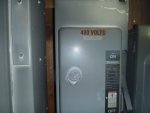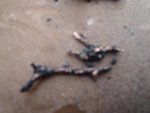I think it is pretty clear from the picture that the arc was located either at the left hand switch contact or the upper left hand fuse clip.
Based on the handle being jammed and looking at the carbon pattern, I think it is slightly more likely that the arc was in the switch, but the initiating event might have been at least in part at the fuse clip. I think I see bright metal in the fuse area, where clean unoxidized copper is exposed.
It probably started with overheating because of a bad contact rather than an overload, followed by loss of pressure on the switch contact surfaces and a series arc across the contacts. The current would still be limited by the load on the panel at the time, but with a decent arc distance developing a voltage the energy given off by the sustained arc could be quite substantial.
The internal melting is probably what has jammed the switch in the closed position, but I bet that a continuity tester would see an open circuit across the left switch contacts.
If the fuse is welded to the upper clip, then there probably was arcing there too.


 Can someone enlighten me on what could have caused this arc on the door to this switchgear. This was found at a fire scene this morning. The machine that this switchgear goes to was not suspect to the fire cause but the machine was damaged in the fire. The fuses are not blown. If you zoom in the metal bar over the left fuse is damaged. The switch gear was still on but the main supplying it was off when I arrived. When I tried to move the lever to the off postion it was stuck.
Can someone enlighten me on what could have caused this arc on the door to this switchgear. This was found at a fire scene this morning. The machine that this switchgear goes to was not suspect to the fire cause but the machine was damaged in the fire. The fuses are not blown. If you zoom in the metal bar over the left fuse is damaged. The switch gear was still on but the main supplying it was off when I arrived. When I tried to move the lever to the off postion it was stuck.


